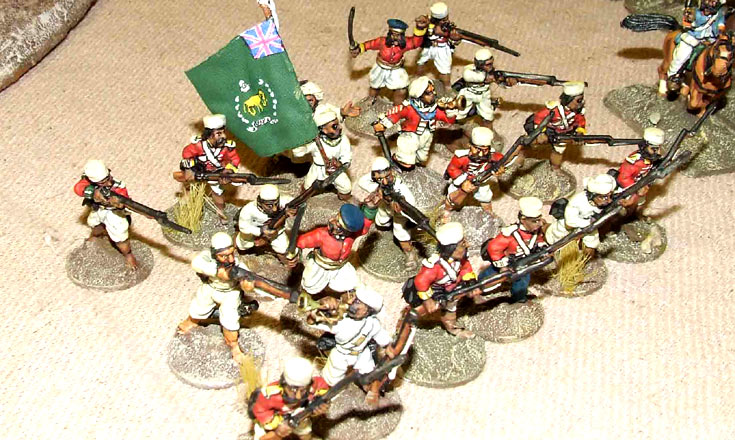
Cowpai, 1857
13th August 2009, Comments Off
Queen Victoria’s Little Wars, Honour & Fortune, 28mm
The Indian Mutiny hasn’t had an airing for over a year, hence this game. We also wanted to experiment with the rules we use. Our standard set (a variant of a Chris Peers system) never really reflected this very quirky period, while another rules set – Sepoy – were realistic, but some people didn’t like them, as they games were one-sided. This time Colin Jack unearthed Honour & Fortune, a set designed to reflect horse & musket warfare in India. Like most Mutiny games, this involved a besieged British outpost and a relief column. Two groups of mutineers were out to stop them, one of which was commanded by Hugh Wilson, who was rated “imbecilic” for the day! You just know that can’t be good. My elephant-mounted princeling was “average”, which seems to be as good as it gets for the Mutineers. A similar ratings system was used for the troops themselves, who were divided into aggressive, active, passive and cowed.
Like most Mutiny games, this involved a besieged British outpost and a relief column. Two groups of mutineers were out to stop them, one of which was commanded by Hugh Wilson, who was rated “imbecilic” for the day! You just know that can’t be good. My elephant-mounted princeling was “average”, which seems to be as good as it gets for the Mutineers. A similar ratings system was used for the troops themselves, who were divided into aggressive, active, passive and cowed. This rating influenced movement (“cowed” units only move if 1-2 is rolled on a D6), as well as fighting ability and morale. While a few Mutineer units were rated as highly as “active”, the British were mostly of a dauntingly “aggressive” quality.
This rating influenced movement (“cowed” units only move if 1-2 is rolled on a D6), as well as fighting ability and morale. While a few Mutineer units were rated as highly as “active”, the British were mostly of a dauntingly “aggressive” quality. To reach the beleaguered outpost the British had to pass through a town which was solidly held by the Mutineers. Actually they chose to by-pass it, which was eminently sensible, seeing as how the “imbecilic” Mutineer commander and his poor quality units found it hard to react to events. The column marched past the settlement, detaching a unit of Sikhs to deal with some Ghazi fanatics, and to screen the advance from any flank attack by the more motivated mutinous sepoys.
To reach the beleaguered outpost the British had to pass through a town which was solidly held by the Mutineers. Actually they chose to by-pass it, which was eminently sensible, seeing as how the “imbecilic” Mutineer commander and his poor quality units found it hard to react to events. The column marched past the settlement, detaching a unit of Sikhs to deal with some Ghazi fanatics, and to screen the advance from any flank attack by the more motivated mutinous sepoys. The trouble was, just over a small river another large force of mutineers was approaching from the east, supported by guns and cavalry. The problem for these mutineers though was their advance was very slow, as we kept failing our movement rolls!
The trouble was, just over a small river another large force of mutineers was approaching from the east, supported by guns and cavalry. The problem for these mutineers though was their advance was very slow, as we kept failing our movement rolls! As a result the British won the race to the outpost. Apart from some long-range musketry and one ineffectual turn of firing by the Sepoy artillery, the only action of any note was a cavalry scrap. In order to buy time for their colleagues the small detachment of British horse charged the far larger mob of Mutineer cavalry. This time though the Mutineers did fairly well, and the gallant British were whittled down until the few survivors pulled back. By that time though it was all over.
As a result the British won the race to the outpost. Apart from some long-range musketry and one ineffectual turn of firing by the Sepoy artillery, the only action of any note was a cavalry scrap. In order to buy time for their colleagues the small detachment of British horse charged the far larger mob of Mutineer cavalry. This time though the Mutineers did fairly well, and the gallant British were whittled down until the few survivors pulled back. By that time though it was all over. The defenders of the outpost had been rescued, and could be withdrawn to safety, and there was nothing the Mutineers could do about it. Victory was duly awarded to the British, but the game was a well-balanced one, and the rules certainly did what we wanted. In fact, with some tinkering I’m sure they’ll become our favoured set of Indian Mutiny rules – the best we’ve found at capturing the period.
The defenders of the outpost had been rescued, and could be withdrawn to safety, and there was nothing the Mutineers could do about it. Victory was duly awarded to the British, but the game was a well-balanced one, and the rules certainly did what we wanted. In fact, with some tinkering I’m sure they’ll become our favoured set of Indian Mutiny rules – the best we’ve found at capturing the period.




